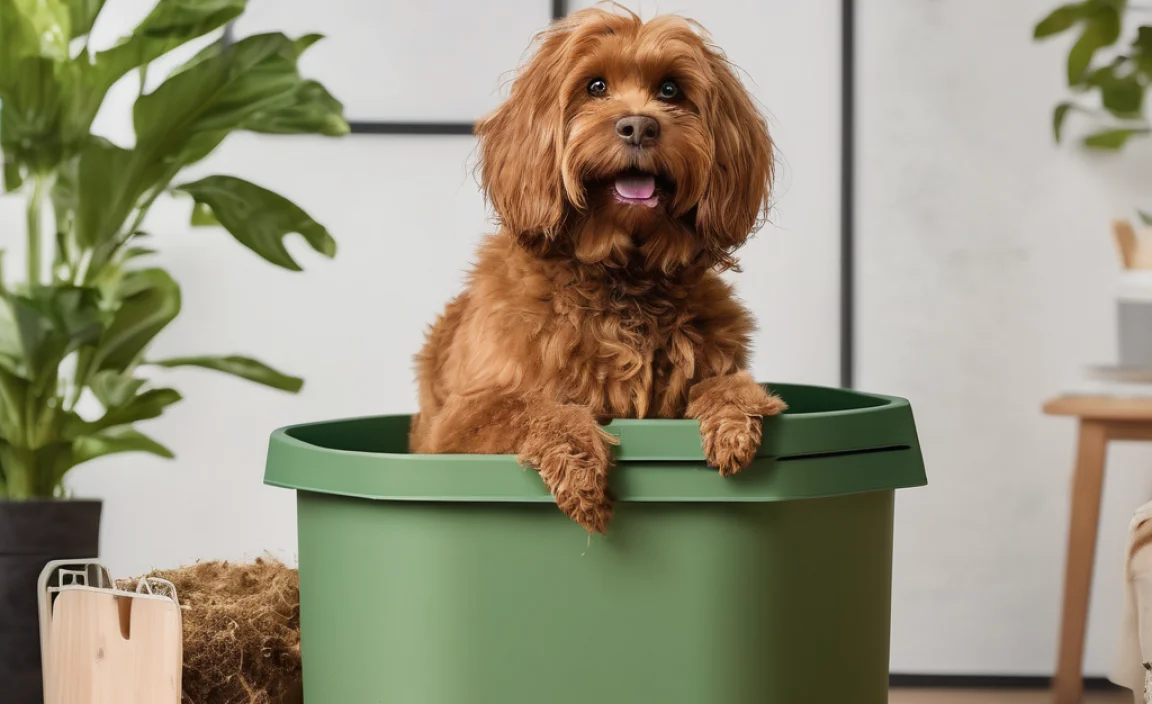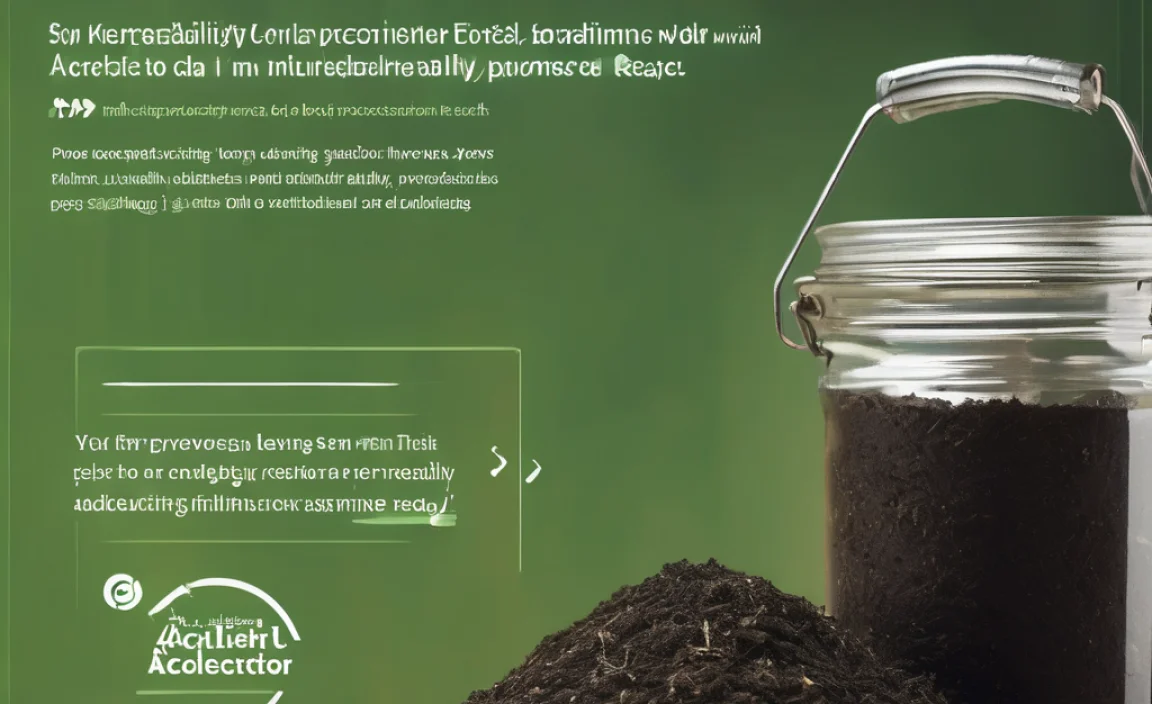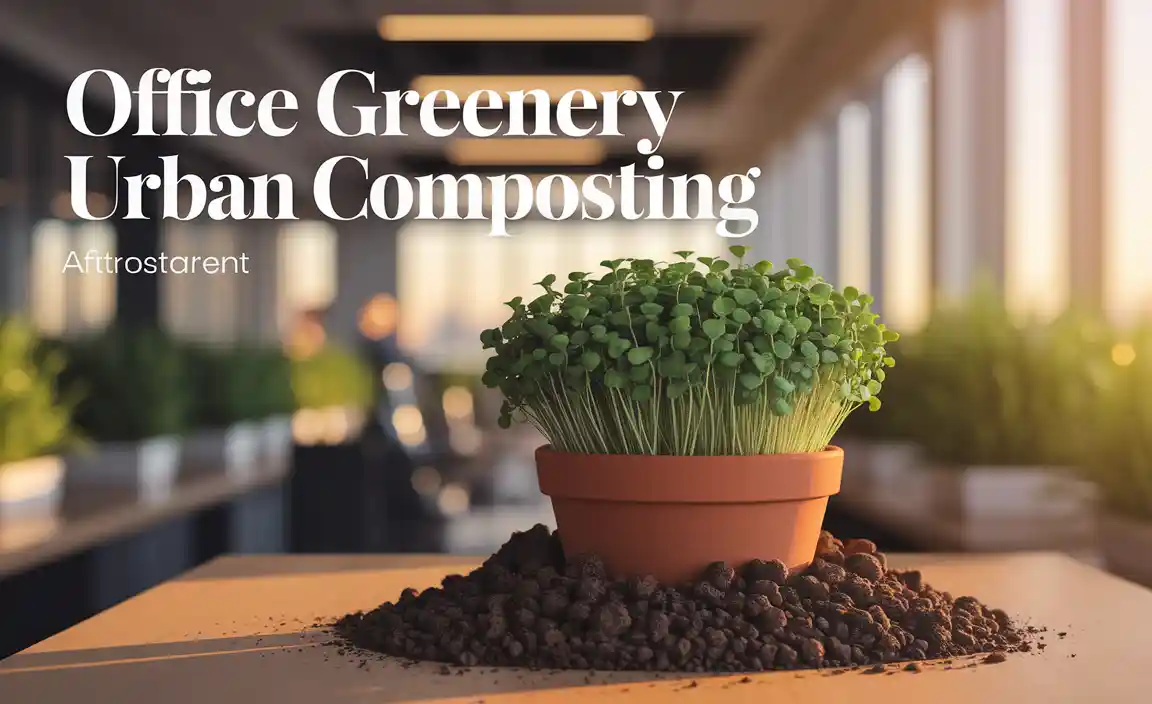Ever thought about what to do with pet waste? It’s a common backyard question, especially for dog and cat owners. You want to be a good pet parent and neighbor, but traditional disposal can feel wasteful or even smelly. What if there was a super simple, effective way to turn that pet waste into something useful, right in your own yard? Well, good news – there is! We’re going to walk through how to set up and use a rotating bin system specifically for composting pet waste. It’s easier than you think, and by the end, you’ll have everything you need to get started. Let’s dive in!
The TopChooser Guide to Rotating Bin Composting for Pet Waste

Hey there, fellow homeowners and DIY enthusiasts! Troy D Harn here from TopChooser, back to help you tackle another home project that’s big on benefits but small on hassle. Today, we’re talking about something a lot of us deal with daily: pet waste. It’s a fact of life for millions of us, and let’s be honest, it’s not exactly the most glamorous part of pet ownership. But what if I told you that this “problem” can actually be a solution? We’re going to explore how to use a rotating bin composter to manage your pet’s waste effectively. It’s a smart, eco-friendly, and practical approach that can even give you fantastic compost for your garden. Forget the smell, forget the waste – let’s make compost!
Why Compost Pet Waste? The Big Picture
Composting pet waste might sound a little… yucky at first. I get it. But stick with me, because the benefits are pretty compelling. When you compost pet waste properly, you’re diverting it from landfills where it can produce harmful methane gas. Plus, you get nutrient-rich compost that’s amazing for your ornamental plants and lawn (though I’d steer clear of using it on edible gardens for safety reasons, which we’ll get to!). It’s about turning a small daily chore into a sustainable win for your home and the environment.
The Rotating Bin Advantage
So, why a rotating bin specifically for pet waste? Unlike stationary compost piles, these bins are designed for easy turning. This is crucial for composting pet waste because it helps the materials break down faster and more evenly. The constant aeration from turning also helps to manage odors and ensures that the pile gets hot enough to kill off harmful pathogens. It’s a more contained and efficient system, making it ideal for smaller yards or for those who want a tidier composting solution.
Is it Safe to Compost Pet Waste? Let’s Get Real.
This is probably your biggest concern, right? And it’s a totally valid one. Pet waste, particularly from carnivores like dogs and cats, can contain various pathogens (like E. coli and Salmonella) that aren’t good for humans. The key to safe pet waste composting is to ensure the compost pile gets hot enough, consistently, to kill these pathogens. This is where the rotating bin really shines. By trapping heat and allowing for regular turning and aeration, it creates the conditions necessary for a thermophilic (hot) composting process.
According to the U.S. Environmental Protection Agency (EPA), compost needs to reach temperatures between 131°F (55°C) and 160°F (71°C) and be maintained for a specific period to kill pathogens and weed seeds. While achieving and monitoring these temperatures perfectly can be tricky, a well-managed rotating bin system significantly increases your chances.
Important Note: To be absolutely safe, especially if you have young children, elderly individuals, or immunocompromised people in your household, it’s generally recommended to use compost from pet waste only on ornamental plants, trees, and lawns – never on fruits, vegetables, or herbs that you’ll eat.
What You’ll Need: Your Rotating Bin Composting Toolkit
Setting up your rotating bin system is straightforward. You don’t need a ton of fancy equipment. Here’s a basic rundown:
Essential Items:
- A Rotating Composter Bin: These are readily available online or at garden supply stores. Look for one made of durable, food-grade plastic or metal, with a good seal to minimize pests. Capacity is key – choose one large enough for your pet’s waste output. A 50-70 gallon size is often a good starting point for a small to medium-sized dog.
- Pet Waste Bags: Biodegradable or compostable pet waste bags are ideal. They make collection easy and can be added directly to your bin.
- “Brown” Materials: These are carbon-rich materials that balance the “green,” nitrogen-rich pet waste. Think shredded cardboard (uncoated), dry leaves, straw, sawdust (from untreated wood), or wood chips.
- “Green” Materials (Optional but helpful): Kitchen scraps (vegetable peels, coffee grounds, tea bags) can be added to help kickstart the composting process and provide nitrogen. Avoid meat, dairy, and oily foods in your kitchen scraps.
- Water Source: A hose or watering can to keep the compost moist.
- Gloves: For happy hands during collection and turning.
- Compost Aeration Tool (Optional but Recommended): Some bins have built-in turning mechanisms. If yours doesn’t, a pitchfork or a specialized aerator can help.
What to Look For in a Rotating Composter:
When you’re shopping for a rotating composter, keep these features in mind:
| Feature | Why It Matters |
|---|---|
| Durable Material | Needs to withstand weather and constant use. UV-resistant plastic or sturdy metal. |
| Airtight Lid | Helps retain heat and moisture, and keeps pests out. |
| Easy Tumbling Mechanism | Crucial for aeration and efficient breakdown. Look for smooth rotation. |
| Drainage Holes | Prevents the compost from becoming waterlogged. |
| Capacity | Match it to the amount of waste you generate. |
Getting Started: Setting Up Your Rotating Bin
Here’s how to get your composting system up and running:
- Choose the Right Location: Find a spot in your yard that’s relatively level, has good drainage, and is conveniently located for both waste collection and occasional turning. Partial sun is usually ideal – too much direct sun can dry it out too quickly, while deep shade might keep it too cool. Make sure it’s not too close to your house or neighbor’s fence.
- Assemble Your Bin: Follow the manufacturer’s instructions to put your rotating composter together. This usually involves clicking or screwing a few parts into place.
- Add a Base Layer: Start with a layer of bulky “brown” material, like wood chips or straw, at the bottom. This helps with drainage and aeration right from the start. Aim for about 4-6 inches.
- Gather Your Materials: Start collecting your pet waste in biodegradable bags. Also, begin collecting your “brown” materials.
The “How-To”: Composting Your Pet’s Potty Patrol
This is the core of it! Managing your pet waste in the bin is a continuous process. Here’s the rhythm:
Step 1: Collection is Key
As soon as your pet does their business, scoop it up using your pet waste bags. If you’re using compostable bags, you can toss them straight into the bin.
Step 2: Adding to the Bin
Here’s the crucial part for balancing the compost and managing odors:
- Always bury fresh waste: When you add pet waste (which is nitrogen-rich “green” material), always cover it with a generous layer of “brown” material. Think of it like tucking the waste into bed with a good amount of leaves, shredded cardboard, or sawdust. A 1:1 ratio of green to brown by volume is a good target, but with pet waste, leaning towards more browns is wise. Aim for at least 2-3 inches of browns for every inch of waste.
- Add your browns: Keep a bin or pile of your “brown” materials near the composter for easy access.
Step 3: Maintaining Moisture
Compost needs to be moist, like a wrung-out sponge. If your compost seems dry, add some water. If it’s too wet (and smelly), add more “brown” materials. The rotating bin helps with this as it keeps everything contained.
Step 4: Turning & Aeration – The Rotating Magic!
This is where the rotating bin really earns its keep. Regularly turn or tumble your compost.
- How often? Aim to turn it 1-2 times per week. After adding waste and covering it with browns, give it a good tumble.
- Why? Turning mixes the materials, introduces oxygen (which speeds up decomposition and reduces odors caused by anaerobic bacteria), and helps distribute moisture. It also ensures that all the material passes through the hottest part of the composting process.
Step 5: The Waiting Game (and Monitoring)
Composting time varies depending on temperature, moisture, materials, and how often you turn it. It can take anywhere from a few weeks to a few months. Keep an eye on the material. It should start to look dark, crumbly, and earthy, with no recognizable pet waste or offensive odors.
Step 6: Using Your Compost
Once the material is finished and looks and smells like rich soil, it’s ready to use. Remember our safety note: stick to ornamental areas. You can spread it around trees, shrubs, and flower beds, or mix it into the top few inches of your lawn. It’s a fantastic natural fertilizer!
What CAN and CAN’T Go In Your Pet Waste Compost Bin
Getting the mix right is important for successful composting and odor control. Here’s a quick reference:
YES, These Are Compostable:
- Dog and cat feces (scooped)
- Pet waste bags (biodegradable/compostable)
- Shredded cardboard and newspaper (non-glossy)
- Dry leaves and straw
- Wood chips and sawdust (from untreated wood)
- Grass clippings (in moderation)
- Yard trimmings (small twigs, dead plants)
- Fruit and vegetable scraps (from your kitchen)
- Coffee grounds and tea bags
NO, Avoid These:
- Meat, bones, dairy products, and oily foods (attract pests, cause odors)
- Diseased plants
- Weeds that have gone to seed (unless your pile reliably gets very hot)
- Plastics, metals, glass
- Coal ash or charcoal briquettes
- Pet waste from sick animals (consult your vet if unsure)
- Cat litter (most types are not compostable and contain pathogens)
Troubleshooting Common Composting Pests (and Smells!)
Even with a rotating bin, you might run into a few hiccups. Don’t get discouraged – these are usually easy fixes!
Problem: It Smells Bad (Ammonia or Rotten Eggs)
- Too much “green”: You might have too much nitrogen-rich material (pet waste, kitchen scraps).
- Solution: Add more “brown,” carbon-rich materials like shredded cardboard, leaves, or straw. Turn the bin thoroughly to aerate.
Problem: It’s Not Breaking Down
- Too dry: Compost needs moisture to work.
- Solution: Add water until it’s like a wrung-out sponge.
- Too wet: Can lead to anaerobic conditions and smells.
- Solution: Add more dry “brown” materials and turn well.
- Not enough “green”: Might be lacking nitrogen to fuel the microbes.
- Solution: Add a bit more kitchen scraps or fresh pet waste (covered well with browns!).
- Needs turning: Lack of air is a major culprit.
- Solution: Turn the bin more frequently.
Problem: Pests (Flies, Rodents, etc.)
- Attracted by exposed food or waste: This is usually a sign of improper covering or materials you shouldn’t have added.
- Solution: Ensure all pet waste and kitchen scraps are buried deep within the bin and always covered with a thick layer of “brown” material. Make sure the lid is secure. Avoid adding meat, dairy, or oily foods. A well-functioning, hot compost pile will deter most pests.
A Note on Pathogen Destruction: Reaching the “Hot” Zone
As we mentioned, the goal is to kill pathogens. While a rotating bin helps, achieving consistent high temperatures (131°F+) takes effort. Many home composters, even rotating ones, may not consistently reach these high temperatures. This is why the recommendation to only use the compost on ornamental plants is so important. For those who want to be extra sure, a compost thermometer can be a useful tool. It helps you monitor if your pile is heating up sufficiently and for how long.
For more details on compost temperatures and pathogen reduction, the Community Garden Association’s resources offer valuable insights, though they are U.K.-based, the principles are universal.
Can I Compost Cat Litter?
This is a common question, and generally, the answer is no, not most cat litter. Most commercial cat litters are made from clay or silica, which are not compostable. Furthermore, cat feces can contain a parasite called Toxoplasma gondii, which can survive in compost that doesn’t reach high enough temperatures. Dog waste also carries risks, but cat waste is considered higher risk for composting at home due to Toxoplasma. Stick to scooping the waste directly and avoiding the litter itself in your compost bin.
Conclusion: Your Composting Journey Starts Now!
There you have it! Composting pet waste using a rotating bin isn’t rocket science. It’s a practical, sustainable way to manage a common household byproduct and create a valuable resource for your yard. By following these steps – choosing the right bin, maintaining a good mix of materials, keeping it moist, and turning it regularly – you can successfully transform your pet’s waste into nutrient-rich compost for your flower beds and lawn. Remember the safety guidelines, and enjoy the satisfaction of a greener, more eco-friendly home. Happy composting!
FAQ: Your Rotating Bin Pet Composting Questions Answered!
Q1: How much pet waste can I realistically compost?
A: The amount depends on your bin’s capacity and how diligently you balance green and brown materials. A 50-70 gallon bin is usually sufficient for one medium-sized dog. For multiple pets or larger breeds, you might need a larger bin or a second system.
Q2: How long does it take for pet waste to compost?
A: It can take anywhere from 3 weeks to several months. It depends heavily on temperature, moisture, the ratio of materials, and how often you turn the bin. Hotter weather speeds things up!
Q3: Will rotating bin composting of pet waste smell bad?
A: If managed correctly with a good ratio of “brown” materials and regular turning, odors should be minimal and earthy, not offensive. The key is to always cover fresh waste with browns, keep the moisture level right, and ensure good aeration.
Q4: Can I use the compost on my vegetable garden?
A: It’s generally not recommended to use compost made from pet waste on edible plants due to the potential presence of harmful pathogens. Only use it on ornamental plants, trees, and lawns.
Q5: What if I don’t have “brown” materials readily available?
A: Stockpile them! Collect dry leaves in the fall, shred old cardboard boxes, or save sawdust from any untreated wood projects. Keeping a good supply of brown material near your composter is essential for successful pet waste composting.
Q6: My bin is full of pet waste and browns. What now?
A: Once your bin is full, you can either stop adding new material and let it finish composting (this will take longer), or you can get a second bin to start filling while the first one matures. Continuing to turn the full bin is important for proper decomposition.
.lwrp.link-whisper-related-posts{
margin-top: 40px;
margin-bottom: 30px;
}
.lwrp .lwrp-title{
}.lwrp .lwrp-description{
}
.lwrp .lwrp-list-container{
}
.lwrp .lwrp-list-multi-container{
display: flex;
}
.lwrp .lwrp-list-double{
width: 48%;
}
.lwrp .lwrp-list-triple{
width: 32%;
}
.lwrp .lwrp-list-row-container{
display: flex;
justify-content: space-between;
}
.lwrp .lwrp-list-row-container .lwrp-list-item{
width: calc(25% – 20px);
}
.lwrp .lwrp-list-item:not(.lwrp-no-posts-message-item){
max-width: 150px;
}
.lwrp .lwrp-list-item img{
max-width: 100%;
height: auto;
object-fit: cover;
aspect-ratio: 1 / 1;
}
.lwrp .lwrp-list-item.lwrp-empty-list-item{
background: initial !important;
}
.lwrp .lwrp-list-item .lwrp-list-link .lwrp-list-link-title-text,
.lwrp .lwrp-list-item .lwrp-list-no-posts-message{
}@media screen and (max-width: 480px) {
.lwrp.link-whisper-related-posts{
}
.lwrp .lwrp-title{
}.lwrp .lwrp-description{
}
.lwrp .lwrp-list-multi-container{
flex-direction: column;
}
.lwrp .lwrp-list-multi-container ul.lwrp-list{
margin-top: 0px;
margin-bottom: 0px;
padding-top: 0px;
padding-bottom: 0px;
}
.lwrp .lwrp-list-double,
.lwrp .lwrp-list-triple{
width: 100%;
}
.lwrp .lwrp-list-row-container{
justify-content: initial;
flex-direction: column;
}
.lwrp .lwrp-list-row-container .lwrp-list-item{
width: 100%;
}
.lwrp .lwrp-list-item:not(.lwrp-no-posts-message-item){
max-width: initial;
}
.lwrp .lwrp-list-item .lwrp-list-link .lwrp-list-link-title-text,
.lwrp .lwrp-list-item .lwrp-list-no-posts-message{
};
}

I am passionate about home engineering. I specialize in designing, installing, and maintaining heating, ventilation, and air conditioning systems. My goal is to help people stay comfortable in their homes all year long.


